Masako Onodera Yun: Would it be safe to say that you have an interdisciplinary art background? Could you introduce your background?
Masako: I have a BFA in interior design. After my graduation, I worked in Tokyo for 8 years as a furniture designer and landscape architect. My interests in college were designing public spaces so I chose to be a landscape designer for the public parks and enjoyed it so much. There was something about designing a space where it will stay in the memory of people’s everyday life. But I also really liked to make things with my hands. I had an opportunity to see a studio glass art exhibition when I was in high school and I really liked it. So I started glass blowing when I got a full time job. I was a weekend glass blower for 8 years before I decided to move to California to pursue my career in glass art. After I spent 3 years working as a glass blower there, I started to see the limitation in the materials to express my thoughts. So I started to use other materials such as wood and metal in my glasswork. I was naturally drawn to metal because of the tranquility of the process and its strength, which was totally opposite from glass. I began to see the personality of each material and its processes carefully. When I decided to go to a graduate school, I chose a program that gave me freedom to use a variety of mediums, but within the craft field.
Yun: Could you explain what drew you to jewelry art? Masako: While I was experimenting with unfamiliar materials to make an abstract form, I accidentally made a little object, which looks like a part of the body. It gave viewers disturbing feelings, but made them curious about it. | 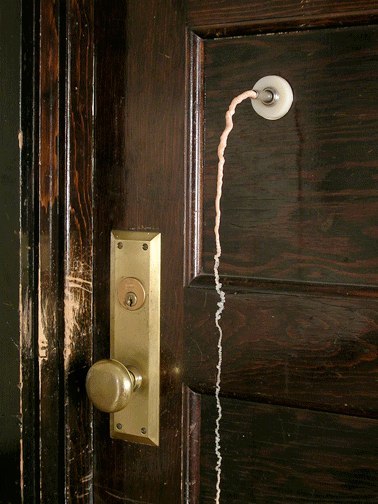 Connective Tissue, Polyurethane, Polyethylene, etc. |
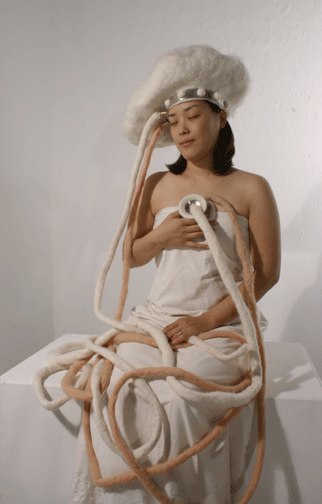 Self Purifier 2006 Wool, Nickel Silve
| 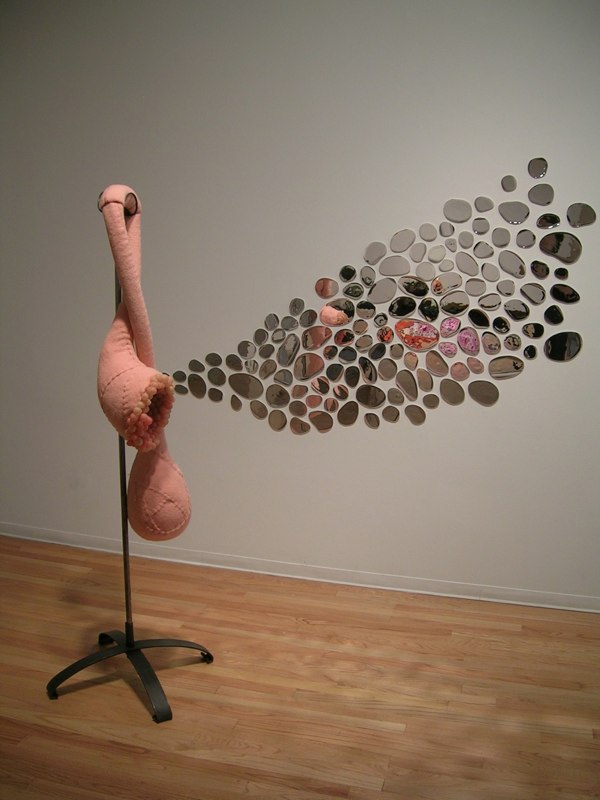 Reminiscence 2008 Appendage1, reflective sheet, steel
|
...I consider the body as a sack filled with multiple tubes to collect, extract, discharge and reproduce. -Masako Onodera
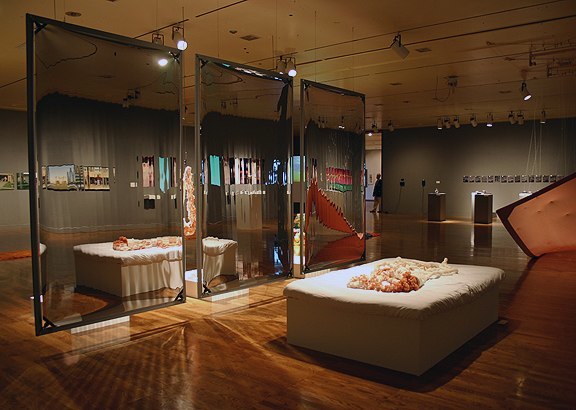 Appendage 3, Wool, cotton, nylon, found object, nylon thread, imitation pearl, styrofoam Group Exhibition "Objects in Mirror are Closer than They Appear" April 2008, Krannert Art Museum, University of Illinois at Urbana-Champaign | I made it into jewelry forms, such as
necklaces or brooches to attach to the actual body. It opened the door for me
to discover the power of the jewelry. This art form allows viewers to touch it
and gave another level of experience that other forms of art cannot do. Moreover, the body transports jewelry to our
everyday life from the gallery setting. I see jewelry as not merely a body
adornment, but also the active art form that can invade the viewer and wearer
quietly. I enjoy its hidden power so much. Yun: The titles of your works are related to cell proliferation, such as Flesh Propagation, Eruption Cuff and Fleshy Pearls. I believe that using and understanding the human body might be an important starting point to understanding jewelry making. Whenever I see work by jewelry artists, discovering how the artist defines the body is the first thing I try. Judging by your work, my interpretation is that you don't consider the human body as a canvas. Instead of your work being an object separated from the body and the background, your objects look like the extension of a phantom image of the body. I thought that the color and states of congelation of the shapes that you are choosing for the objects have images and textures that take after skin, secretions, and cartilage. The name of the necklace work, Gizmo, indicates a possible function. |
Furthermore, for large scale objects, bodily organs are emphasized and the title of the works are more directly related to organs, such as appendage. As you said in an artist statement “When it is on the body, it does not decorate the wearer to show one’s status, but identifies the wearer as a living human being.” So your work is not located outside of the body to be considered a minor part of it, it is an organ moving out from the body and to prove the life of the body. What is the definition of the body for you? Masako: I consider the body as a sack filled with multiple tubes to collect, extract, discharge and reproduce. We are quite simple. We think we know it, but tend to forget about it.
Yun: Like skin and hair, exposed organs give a social signal for potential interaction with others. Interestingly, this returns to the traditional purpose of jewelry. Something else I can see is that multiple people can share "the organ." In the work Appendages (2008), the organ dominates the bodies of the wearers and makes them one united body. Like the question at the end of your artist statement, "Who am I?" people who are wearing your work lose their identity and became “a body.” I am not sure whether you would agree with this or not, but it reminds me of the "third impact" part of the animation Neon Genesis Evangelion. Have you ever seen it? Masako: No. |  Appendage 3, Wool, cotton, nylon, found object, nylon thread, imitation pearl, styrofoam Group Exhibition "Objects in Mirror are Closer than They Appear" |
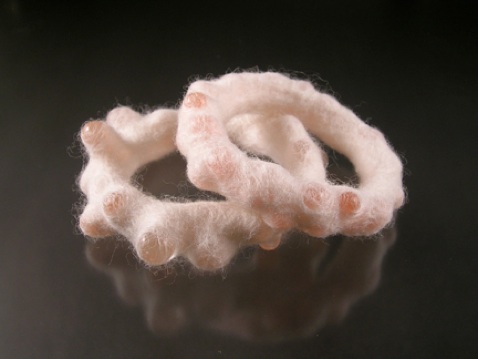 Gristle Glass, Wool, Plasti-dip 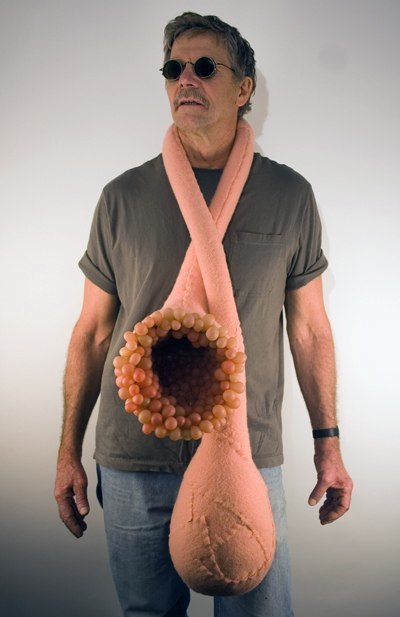 Appendage1 2008
Found objects, wool, copper, brass | 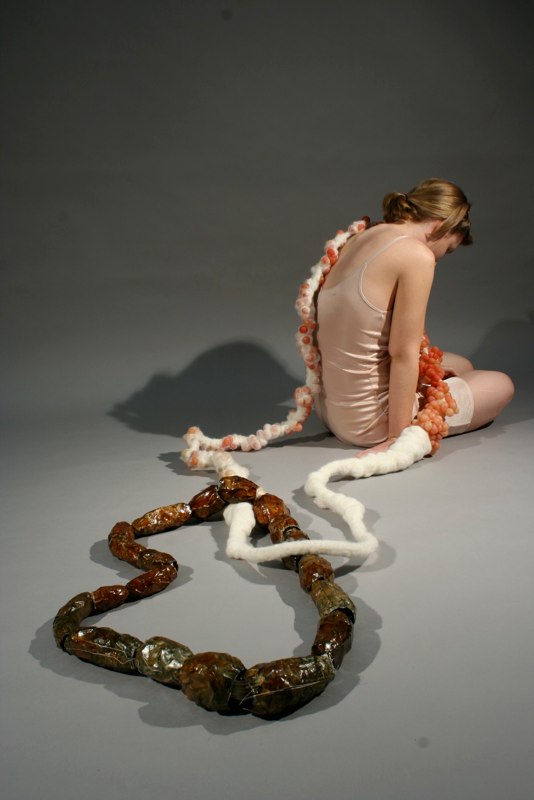 Circulation 2008 Yun: In the TV series of the animation, when the “third
impact” happens, when finally people realized what the Human Instrumentality Project is about, all humans became one fluid
unity to recover the limitations of an individual. Such limitations include
communications, memories, and desire of approval from others. The story could
be based on the loneliness caused by the isolation of individuals at that time
period, and talk about how we need “others” to define ourselves. But that the
same time, like Sartre said, “Hell is other people,” it seems impossible to
find a break from others. The “third impact” of the last episode of Neon Genesis Evangelion caused a lot of debate among many people. I remember that I also discussed it all day long with my friends! Even though I wasn’t even a big fan of the animation. I was more into other animations by the Gainax company. Anyway, the director Hideaki Anno was even threatened with blackmail because of the ending. I believe that it isn't clear if the ending was happy or sad. It was the death of the human when combined with others to become a new human by losing the imperfections of individuality, such as a person who has experienced a trauma and is built by memories, relationships, and a self-judgmental attitude. |
Masako: That is an interesting story! I
am also interested in what is beauty. A lot of people are traumatized by how
they look, so they spend so much effort to pursue the idealized beauty. A lot
of people cannot accept their own imperfection and aging processes. What is
imperfection, anyway? Plastic surgery and obsessive exercising are typical activities that people are getting
into. It has always been pain and
disturbing incidents behind the ideal beauty since ancient times, such as
scarification, tattoo, and body modifications. But I believe imperfections
create individuality, and make our sacks unique. If you loose your own unique
sack and share something else with others, you will lose your identity. Yun: Looking at
some photos of your work, I feel that the organ becomes others, but at the same
time is still part of the body. For example, in the photo of Circulation (2008), the model who is
wearing the work looks like she might be separated/isolated from her own
intestine, but it seems they could possibly be having a conversation. In this
case, the wearer is actually becoming an organ. In addition, it seems like it
is showing a phantom image of some sort of trauma or sickness that she might
have. As shown in other photos, by allowing for the wearing of the organs
together, by more than one person, the wearers become one body and sharing the
intestine is an invitational gesture. What are you dreaming through your work? Can you imagine an
ideal image of the body through your work? |  Guest, Glass, Sterling Silver, Plasti-dip 3 1/2"x 4 2/1" x 1 (each) |
Masako: I see my work as sort of a meditation device. The viewers can touch it with their hands and feel it with their skin. I want their body to engage with my work fully using their senses. When it occurs, the body can go back to being merely a sack with tubes. Yun: My guess is that you start considering your work as a sculpture with The Way of Flesh Day 19 (2007). Is that right? I think this work has another relationship with space, as an independent object that has its own lifetime. Like you called your necklace Gizmo, it seems like a specific type of organic equipment. Masako: I have been thinking about the role of a craftsperson. To say it simply, I think we are making tools: extensions of our body. Simple functional pieces are very much an extension of our hands. Decorative art has a function to decorate a space or person, right? But the pieces can convey the owner’s wealth, power, lifestyle, or memory of a person and etc. Possibly, the piece can carry the present and show the maker’s skill. They are the tools to show the owner’s identity. I cannot separate my work as an artist and craftsperson from the phantom of body. I also think of my work somewhat as a tool to let viewers to experience something. Yun: Is this work a turning point in that you don't need to have a human body anymore in order to talk about a body as an organ? Masako: Yes. The Way of Flesh was the big step for me to discover the way to create a tool to connect the viewer, space, and time all together. Yun: Can you introduce your new work Path and explain how it is related to your notion of the body? Masako: I had been interested in the cycle of life and fascinated by the very primitive continuance form, a circle. It might be a jump from my lacquer work, Remains. In a variety of cultures, necklaces and bracelets are used to meditate or pray. I also like the continuance process of knotting and linking involved with the making of a circle. The action of knotting has a meaning of connection. My new work Path utilizes the voice of the actions and the property of the materials. The material of wood fascinates me because it responds to moisture differently after its form is changed from a tree to lumber. The lumber with a tree core reacts too actively to the moisture, so it is not considered the best for construction material. So, it is a reject. I carved a 4 x 4 Douglas fir lumber with a core to make it back to a tree form. Then I cut it into beads, and connected them to a circle to let the energy circulate. It was sort of the recovering process to finding a center of the tree, but also culture and myself. I believe I was responding to the tragedy in Japan in March. Yun: Thank you so much for the interview. Oct.20.2011 | 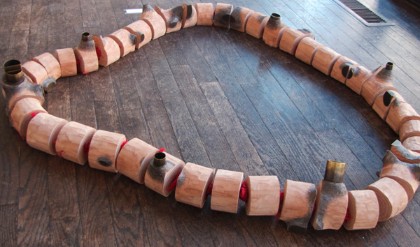 Path, Brass, wood, silk, graphite, 2011 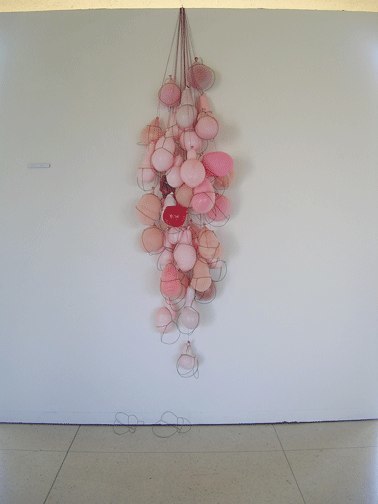 The Way of Flesh day 19 Steel, Cotton Thread, Balloon |
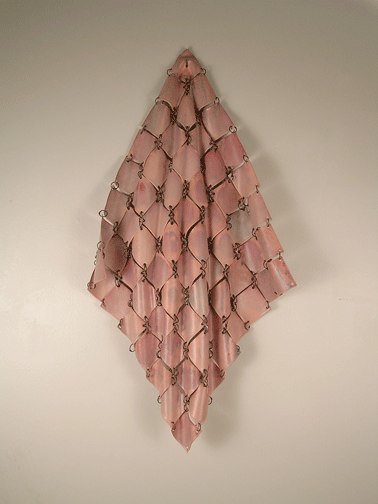 Beautiful Protection Polyurethan, Copper | 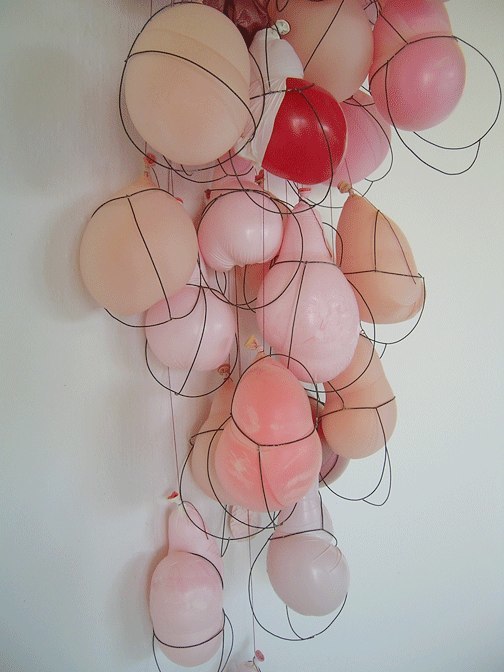 The Way of Flesh day 19 Steel, Cotton Thread, Balloon |
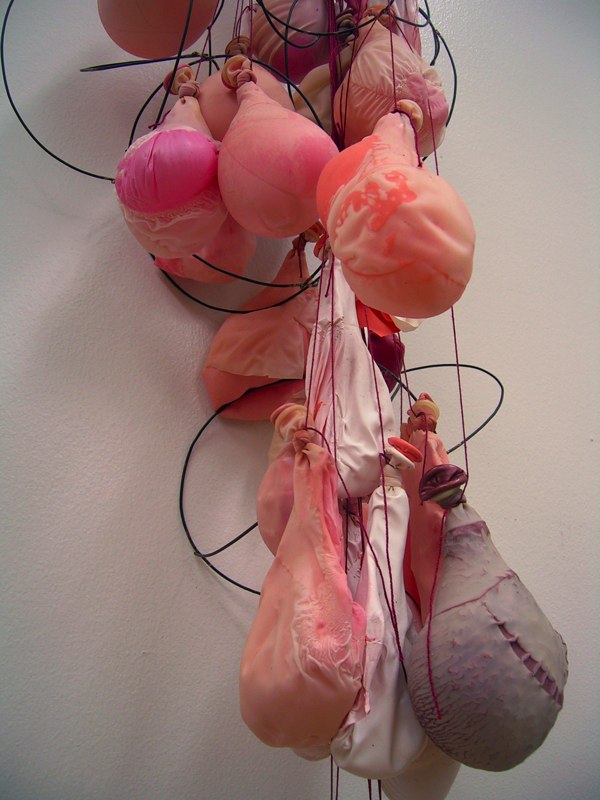 The Way of Flesh day 19 Steel, Cotton Thread, Balloon 9 months later detail | Artist statement My work is the apparatus to awake viewers and wearers of their own bodies and evanescent life. In my work, I present grotesque, and peculiar, but oddly appealing simulated body parts of appendages, representing rampant, uncontrolled growth and decay. They are both sensual and strange, and suggest an experience of the body that is altered by the tactile and visual characteristics of the object. By employing jewelry form, I engage viewers to have physical interaction with my work. When my work is not on the body, it is merely a self-contained object and seduces a viewer’s curiosity with its peculiar and unconsciously familiar form. When it is on the body, it doesn’t decorate the wearer to show one’s status, but identifies the wearer as a living human being. Because of the parallel activity between craft making practices and body beautification practices, engaging the process of craft making practices is an important part of my work. Each of these processes leaves a mark of obsession with ideal beauty, a human fantasy that only objects manage to embody. My jewelry becomes a theatre for the notion of self without decoration. But, after all, the wearer becomes a part of my work and is translated as a part of self-contained object that tells a story. This transformation prompts wearer to have a conversation with oneself that begins with the question, “Who am I?”
|